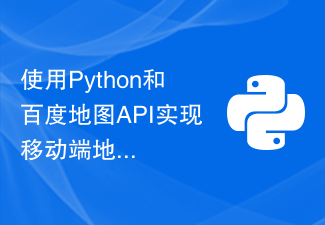As the number of smartphone users continues to increase, mobile web applications have attracted more and more attention and demand, becoming the choice of more and more enterprises and individual developers. As an open source PHP web framework, ThinkPHP6 is also constantly improving its mobile capabilities, providing developers with convenient tools and excellent performance.
This article will introduce how to use ThinkPHP6 to develop mobile web applications. First of all, what we need to understand is the features and optimizations provided by the new ThinkPHP6 for the development of mobile web applications:
- Lightweight view layer rendering engine
For To improve the performance of mobile web applications, ThinkPHP6 uses a lightweight view layer rendering engine that can quickly render views and significantly reduce the memory usage.
- Mobile page adaptation
ThinkPHP6 has a built-in mobile page adaptation mechanism, which can automatically identify the type and screen size of the access device and provide adaptation for different devices view. In this way, developers do not need to write different views for different devices, and efficiency will be greatly improved.
- Responsive layout support
In order to better adapt to various devices, ThinkPHP6 supports responsive layout, which can adaptively adjust the page layout according to the screen size and resolution. Make the page display the best effect on different devices.
In addition to the above points, ThinkPHP6 also provides some other features, such as supporting middleware for mobile terminals, automatic caching of routes, debugging tools for mobile terminals, etc. Below we will introduce in detail how to use ThinkPHP6 to develop a simple mobile web application with examples.
- Environment preparation
First of all, we need to prepare the local development environment, including PHP, MySql, Apache, etc. These tools can be obtained through packages such as XAMPP Integrated, you can also download and install it separately.
Secondly, we need to install Composer. Composer is a PHP package manager that can easily manage and install dependent packages. You can obtain the installation package from the official website, or install it directly through the command line.
Finally, we need to install ThinkPHP6, which can be installed through Composer, or you can download the compressed package directly from the official website and decompress it. This article chooses to install ThinkPHP6 through Composer.
- Quickly build the project
After installing the environment and dependencies, we can start to quickly build the project. You can quickly create a new ThinkPHP6 project using the following command:
composer create-project topthink/think tp6 --prefer-dist
where tp6 is the project name and can be modified as needed. After executing the command, Composer will automatically download and install all dependent packages and create the basic project structure.
- Building routing and controllers
In ThinkPHP6, routing configuration and management is very convenient. We can define routing rules for controllers and methods through annotations. Next, we first create a controller named Index and define a method named hello to output hello world. Create a new app/controller/Index.php file in the project directory. The file content is as follows:
<?php
namespace appcontroller;
use thinknnotationRoute;
class Index
{
/**
* @Route("/")
*/
public function hello()
{
return "Hello world!";
}
}In this controller, we use the Route annotation to define a routing rule for the hello method. The routing rule is the website root. Path/, that is, when the user visits the homepage of the website, this method will be executed to return a string.
Next, we need to open the config/router.php file in the project directory and add the following configuration under the file:
use think
acadeRoute;
Route::get('/', 'index/hello');The function of this configuration is to map /route access to control In the hello method of the server, the response to the user request is implemented. At this point, we have completed the construction of the routing and controller.
- Define views and templates
In ThinkPHP6, the rendering layer of the view has also been further optimized and enhanced. We can use the built-in template engine to define and render view templates, or we can customize and extend the template engine to achieve richer and more flexible effects.
In order to support the mobile terminal, we need to customize a view template that adapts to the mobile terminal. Create a new view/index/index.html file in the project directory. The content of the file is as follows:
<!doctype html> <html> <head> <meta charset="UTF-8"> <meta name="viewport" content="width=device-width, initial-scale=1"> <title>Hello world</title> </head> <body> <h1 id="Hello-world">Hello world</h1> </body> </html>
In this template, we use the HTML5 standard meta tag to define the view adaptation method so that the page can Dynamically adapt according to the screen size of different devices. At the same time, a simple h1 tag is also added to display the text content of hello world.
- Run the test
At this point, we have completed the development of the ThinkPHP6 mobile web application and can conduct simple tests. Enter the project directory and use the following command to start the built-in Web server:
php think run
Then visit http://localhost:8000/ in the browser, and you can see the text content of Hello world. At the same time, the page can also automatically adapt to different devices and display the optimal effect.
- Summary
This article introduces how to use ThinkPHP6 to develop mobile web applications, from environment preparation, project construction to the definition of routing and controllers, and then to views and template definition, and finally verified the correctness and performance of the application through simple tests.
For developers who want to use PHP for mobile web application development, ThinkPHP6 is a good choice. Its lightweight, efficient features and comprehensive mobile support allow developers to quickly build high-quality mobile web applications.
The above is the detailed content of Implement mobile web applications using ThinkPHP6. For more information, please follow other related articles on the PHP Chinese website!
 解决Vue移动端多触点问题Jun 30, 2023 pm 01:06 PM
解决Vue移动端多触点问题Jun 30, 2023 pm 01:06 PM在移动端开发中,我们经常会遇到多手指触控的问题。当用户在移动设备上使用多个手指滑动或缩放屏幕时,如何准确地识别和响应这些手势是一个重要的开发难题。在Vue开发中,我们可以采取一些措施来解决移动端多手指触控问题。一、使用vue-touch插件vue-touch是一个用于Vue的手势插件,它可以方便地处理移动端的多手指触控事件。我们可以通过npm安装vue-to
 Vue开发中如何解决移动端双击放大问题Jun 29, 2023 am 11:06 AM
Vue开发中如何解决移动端双击放大问题Jun 29, 2023 am 11:06 AM随着移动端设备的普及,使用Vue进行移动端开发已经成为了常见的选择。然而,我们在移动端开发过程中经常会面临一个问题,就是双击放大。本文将针对这一问题,探讨在Vue开发中如何解决移动端双击放大的具体方法。移动端双击放大问题的出现,主要是因为移动设备在触摸屏上进行双击操作时,会自动放大网页的缩放比例。对于一般的网页开发来说,这种双击放大通常是有好处的,因为它可以
 使用Python和百度地图API实现移动端地图定位功能的方法Jul 29, 2023 pm 11:33 PM
使用Python和百度地图API实现移动端地图定位功能的方法Jul 29, 2023 pm 11:33 PM使用Python和百度地图API实现移动端地图定位功能的方法随着移动互联网的发展,地图定位功能在移动端应用中变得越来越常见。Python作为一种流行的编程语言,也可以通过使用百度地图API来实现移动端地图定位功能。下面将介绍使用Python和百度地图API实现地图定位功能的步骤,并提供相应的代码示例。步骤一:申请百度地图API密钥在开始之前,我们首先需要申请
 如何处理PHP表单中的移动端和响应式设计Aug 10, 2023 am 11:51 AM
如何处理PHP表单中的移动端和响应式设计Aug 10, 2023 am 11:51 AM如何处理PHP表单中的移动端和响应式设计随着移动设备的普及和使用频率的增加,以及越来越多的用户使用移动设备访问网站,适配移动端成为了一个重要的问题。在处理PHP表单时,我们需要考虑如何实现移动端友好的界面和响应式设计。本文将介绍如何处理PHP表单中的移动端和响应式设计,并提供代码示例。1.使用HTML5的响应式表单HTML5提供了一些新特性,可以方便地实现响
 Vue开发:优化移动端手势缩放卡顿问题Jun 30, 2023 pm 04:33 PM
Vue开发:优化移动端手势缩放卡顿问题Jun 30, 2023 pm 04:33 PMVue开发中如何解决移动端手势缩放页面卡顿问题近年来,移动端应用的普及使得手势操作成为用户交互的重要方式。在Vue开发中,实现移动端手势缩放功能往往会遇到页面卡顿的问题。本文将探讨如何解决这一问题,并提供一些优化策略。了解手势缩放原理在解决问题之前,我们首先需要了解手势缩放的原理。手势缩放通过监听触摸事件来实现,当用户用两个手指滑动屏幕时,页面会按照手指的滑
 Vue移动端消除点击穿透问题的解决方案Jul 01, 2023 am 08:27 AM
Vue移动端消除点击穿透问题的解决方案Jul 01, 2023 am 08:27 AMVue开发中如何解决移动端点击穿透问题移动端上经常会遇到点击穿透的问题,即用户在快速点击元素时,由于点击事件的执行时间较长,下一个元素会被穿透点击。这在开发中会造成一系列的问题,例如多次触发事件、页面跳转错误等。针对这个问题,Vue提供了几种解决方案。一、使用FastClick库FastClick是一个能够消除click事件在移动端300ms的延迟库。安装和
 如何使用PHP生成可用于移动端的二维码?Aug 26, 2023 pm 02:51 PM
如何使用PHP生成可用于移动端的二维码?Aug 26, 2023 pm 02:51 PM如何使用PHP生成可用于移动端的二维码?随着移动互联网的快速发展,二维码成为了商家推广、支付、活动等方方面面的重要工具。而使用PHP生成可用于移动端的二维码则成为了许多开发人员的需求。在本文中,我们将介绍如何使用PHP生成可用于移动端的二维码,并附上代码示例供参考。首先,我们需要先安装并引入一个PHP库,名为"endroid/qr-code"。这个库提供了一
 Vue开发中如何解决移动端图片旋转问题Jun 29, 2023 pm 09:22 PM
Vue开发中如何解决移动端图片旋转问题Jun 29, 2023 pm 09:22 PM随着移动互联网的快速发展,越来越多的网站和应用程序开始采用Vue.js进行移动端开发。然而,在移动端开发过程中,经常会遇到图片旋转的问题。图片旋转是指当用户在移动设备上拍摄照片时,由于设备方向的变化,导致照片在页面上显示的角度与实际拍摄的角度不一致。解决图片旋转问题,首先需要了解图片旋转的原因。当用户在移动设备上拍摄照片时,设备会自动为照片添加一些元数据,其


Hot AI Tools

Undresser.AI Undress
AI-powered app for creating realistic nude photos

AI Clothes Remover
Online AI tool for removing clothes from photos.

Undress AI Tool
Undress images for free

Clothoff.io
AI clothes remover

AI Hentai Generator
Generate AI Hentai for free.

Hot Article

Hot Tools

SAP NetWeaver Server Adapter for Eclipse
Integrate Eclipse with SAP NetWeaver application server.

Dreamweaver Mac version
Visual web development tools

ZendStudio 13.5.1 Mac
Powerful PHP integrated development environment

Atom editor mac version download
The most popular open source editor

SublimeText3 Linux new version
SublimeText3 Linux latest version







